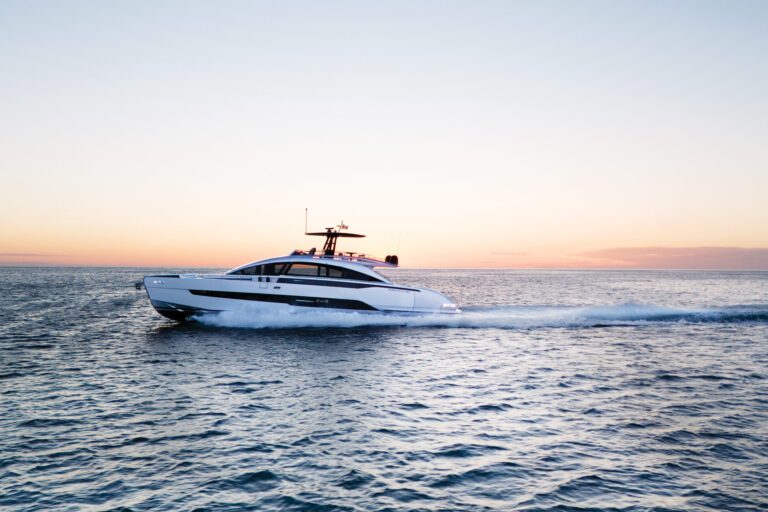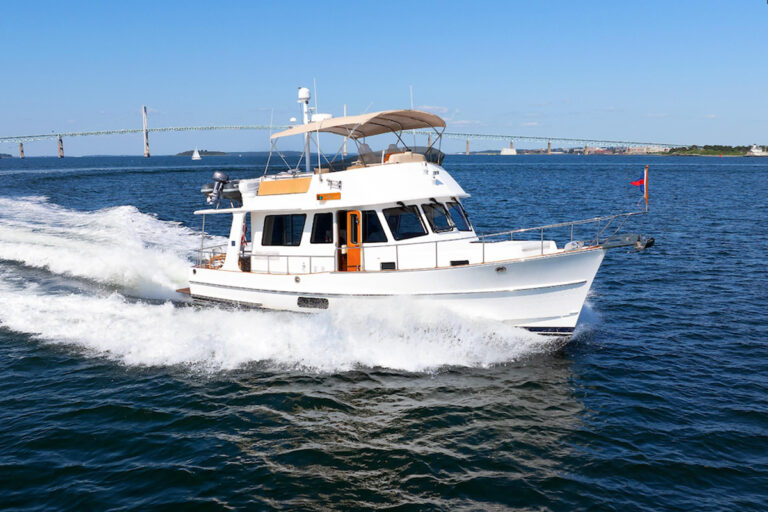Size isn’t everything. While most custom buyers are building ever-larger yachts, a few experienced owners have said, “Enough.” One is the European businesswoman who gave Perini Navi the task of building its smallest vessel in a decade. The result is the cutter Heritage, which, like a flawless gem, is to be cherished for her perfection rather than her bulk.
No one in his right mind would call a 110-foot yacht small, but Heritage was obviously the little sister while undergoing final outfitting at Perini’s Viareggio yard in Italy. She had the visual disadvantage of being moored adjacent to the 173-foot Atmosphere, also nearing completion. Almost anywhere else in the world, Heritage would have been the queen of the port.
The concept for Heritage was to retain a traditional look, inside and out, while incorporating the latest technological developments Perini Navi had to offer. All of this was to be built into a compact package suitable for crewed charter and private use. The result is a study in design at its best.
Boarding via a retractable centerline gangway at the stern, it is only a few steps forward across the teak deck to the outside helm and a spacious arc of companion seating in the cockpit. Flush with the main deck, the cockpit is open to the sun, yet semi-protected from wind and spray by the raised deckhouse immediately forward.
The helmsman is provided a raised teak platform, high enough to afford a clear view over the top of the house and an easy grip on the wood-rimmed destroyer wheel. Controls nearly duplicate those of the inside helm, giving full control over the highly automated sail handling equipment, as well as the engine. There are eight Perini Navi captive winches, plus in-boom furling for the mainsail and roller stays for the genoa and staysail. Only the cruising spinnaker requires handling by crew.
Recessed two steps down from the cockpit is a large, alfresco lounge area that is sure to be a favorite spot aboard Heritage. It is open for easy communication with the helmsman and guests aft, yet shielded from sun and wind. An L-shape settee and teak table are to port, with a wet bar opposite. Royal blue cushions with red piping are the perfect complement for the white-planked overhead with varnished teak trim.
A glass door and large window in the after bulkhead of the wheelhouse allow an excellent view aft from the inside helm and create the visual impression of one large area rather than two smaller ones. The wheelhouse has two chairs at the portside helm, plus a companion seat on the other side of the stair to the saloon. An L-shape settee and table mirror the outside unit, while a navigation station to starboard doubles as an office.
Just down the stairs adjacent to the helm, a beautifully finished flag locker hints at the traditional interior just ahead. The main cabin, serving as both saloon and dining area, is a full-beam space at the widest part of the hull. Decks and bulkheads are finished in light teak; the overhead is white.
Normally, I’m not overly fond of such arrangements, as they tend to be too dark for my tastes. Heritage avoids this by using light upholstery and having two huge fixed portlights on either side of the cabin. Both are fitted with two layers of safety glass. The outer layer is fixed; the inner opens for cleaning.
The saloon has two sofas in an L-arrangement facing a large-screen TV and entertainment center on the after bulkhead. The dining area is banquette-style, seating four on benches and four in chairs around a table big enough for the full complement of eight. It seems an obvious thing, but it is surprising how many yachts have more berthing than seating.
Abaft the main cabin are the guest accommodations, two staterooms that are virtually identical. Each has twin berths plus a Pullman, two hanging lockers and an en suite head with shower. A large portlight, identical to those in the main cabin, is fitted to each stateroom.
Farther aft is the master stateroom, a full-beam arrangement with oversized berths on either side and, on centerline, a built-in desk with bookshelves above. Two large portlights are fitted, bringing in considerable sunshine. Wide teak louvers, here as on the other portlights, are available to close off the view. The master bath, finished in marble, has a large shower with a seat. There is a walk-in closet with considerable hanging capacity, as well as drawers and lockers. A watertight door in the closet allows emergency escape to or from the engineroom.
Placing the engineroom at the stern, using a V-drive gear, is not common in this size sailing yacht, but it has the advantage of allowing uninterrupted deck spaces forward. It also helps keep noise, heat and vibration confined and away from living spaces. Maintenance on all the machinery is easier, and there is a large deck hatch that can be removed for major rebuilds.
The main galley and crew’s quarters, consisting of a small crew mess and two en suite cabins with upper and lower berths, are forward. All tankage is in double bottoms through the yacht’s mid-body, straddling a retractable keel that cuts Heritage’s draft by more than 11 feet.
A tender is stowed in a recessed well on the foredeck to reduce windage and improve visibility. To afford the crew a little private time in the sun, the deck recess converts to a lounge area when the tender is in use.
As mooring space becomes scarce around the world, especially in the most popular cruising locales, more Heritages are likely to be built. The concept of building smaller, but not cheaper, with a high level of comfort and technology, has a lot of advantages. If other builders can do it as well as Perini Navi, it may be the wave of the future.
Contact: Perini Navi S.p.A., (011) 39 584 4241; fax (011) 39 584 424200; sales@perininavi.it. Perini Navi USA, (401) 683-5600; fax (401) 683-5611.





